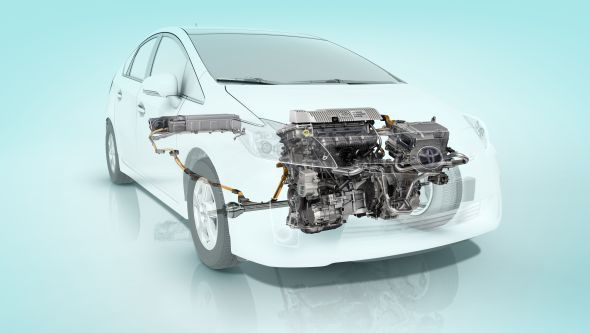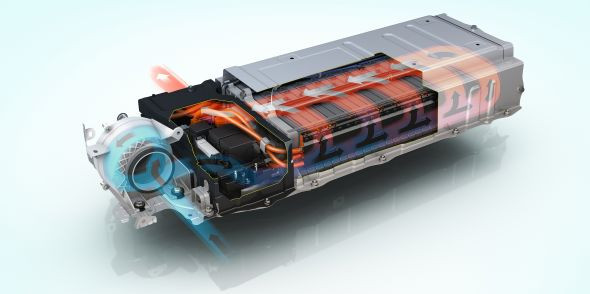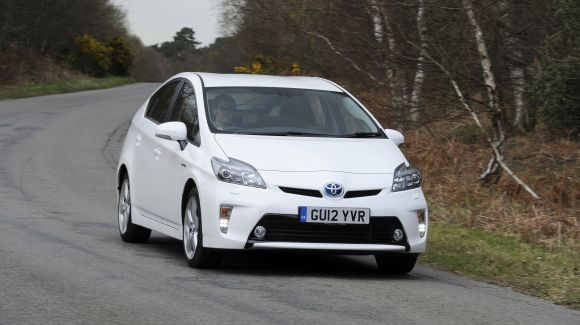What Does Hybrid Mean In Toyota Cars? It means enjoying better fuel economy and lower running costs with a seamless driving experience; you will find the answer to all the questions you have in mind with Miller Toyota, your trusted Toyota dealership in Boise. We offer a wide selection of hybrid models and expert service. Explore the world of Toyota hybrids and discover how they can benefit you. With improved fuel efficiency, reduced emissions, and innovative technology, Toyota hybrids are a smart choice for drivers in Boise and beyond. Let’s dive in and uncover the advantages of driving a Toyota hybrid, including hybrid maintenance, hybrid battery and Toyota hybrid technology.
1. What Exactly Is A Hybrid Vehicle?
A hybrid vehicle combines two or more power sources, typically pairing a traditional internal combustion engine with an electric motor and battery system to enhance fuel efficiency and reduce emissions. Toyota has been at the forefront of hybrid technology.
In essence, a hybrid car uses two engines. According to the EPA, hybrid cars combine the benefits of high fuel economy and low tailpipe emissions with the power and range of conventional vehicles.
1.1 What Are The Different Types Of Hybrid Systems?
There are primarily three types of hybrid systems:
-
Full Hybrids: Such as the Toyota Prius, these vehicles can run on electric power alone, gasoline power, or a combination of both.
-
Parallel Hybrids: These use the gasoline engine as the primary power source, with the electric motor providing assistance.
-
Series Hybrids: In this setup, the electric motor drives the wheels, and the gasoline engine acts as a generator to power the electric motor.
Toyota primarily utilizes the full hybrid system, known as Hybrid Synergy Drive, which optimizes the use of both the gasoline engine and electric motor for maximum efficiency.
 Hybrid Synergy Drive
Hybrid Synergy Drive
2. How Does Toyota’s Hybrid System Work?
Toyota’s Hybrid Synergy Drive system is a sophisticated combination of a gasoline engine, electric motor, generator, power control unit, and a power split device. This system seamlessly and automatically switches between electric power and conventional engine power, adapting to different driving conditions for optimal efficiency and performance.
The Hybrid Synergy Drive is a complex system. When the engine is running, it charges the battery via the generator. In slow-moving traffic, the system can cut out the gasoline engine and let the electric motor take over for zero-emissions traveling. The engine management system senses when the car is stopped and will switch off the engine to conserve power and cut emissions, automatically starting up again when needed.
2.1 What Are The Key Components of Toyota’s Hybrid System?
- Gasoline Engine: Provides primary power for the vehicle.
- Electric Motor: Assists the gasoline engine and can power the vehicle independently.
- Electric Generator: Charges the hybrid battery.
- Power Control Unit (PCU): Manages the flow of power between the engine, motor, and battery.
- Power Split Device: A special gearbox that distributes power from the engine, motor, and generator.
2.2 What Are The Benefits of This System?
According to Toyota, the benefits include:
- Improved fuel economy
- Reduced emissions
- Smooth and quiet driving experience
- Regenerative braking
3. How Does Regenerative Braking Work in Toyota Hybrids?
Regenerative braking is a key feature of Toyota hybrids. It captures the energy produced during braking and uses it to recharge the hybrid battery. This not only improves fuel efficiency but also reduces wear and tear on the brakes.
Toyota’s regenerative braking system is efficient. Every time you put your foot on the brake or lift off the accelerator, the system diverts energy back to the battery where it is, in effect, recycled. Instead of the energy being lost as heat or noise from the brakes, it is captured and then used to power the electric motor later. This is particularly efficient in stop-start traffic where the system recovers and stores a great deal of energy, making the car more efficient overall.
 Hybrid Synergy Drive
Hybrid Synergy Drive
3.1 What Are The Advantages of Regenerative Braking?
- Increased fuel efficiency
- Reduced brake wear
- Extended driving range
- Environmentally friendly
4. Do Toyota Hybrids Need To Be Plugged In?
Most Toyota hybrids do not need to be plugged in. The hybrid battery is charged through the gasoline engine and regenerative braking system. However, Toyota also offers plug-in hybrid electric vehicles (PHEVs) like the Prius Prime, which can be charged at home or at public charging stations for a greater electric-only driving range.
Toyota hybrids offer flexibility. Toyota produces plug-in hybrid electric vehicles for people who can make use of its greater range of more than 30 miles in electric-only EV mode and cars which convert hydrogen into electricity.
4.1 What Are The Benefits of Plug-In Hybrids?
- Greater electric-only driving range
- Reduced reliance on gasoline
- Potential eligibility for tax incentives
- Environmentally conscious driving
5. How Long Do Toyota Hybrid Batteries Last?
Toyota hybrid batteries are designed to last the life of the vehicle. Toyota’s standard battery warranty is five years or 100,000 miles and can be extended up to 15 years with no limit on total mileage.
Toyota hybrid batteries are durable. The batteries are substantial units that have to store sufficient voltage to power the car with no assistance from the gasoline engine. It’s true that their production does have a small, additional environmental impact, but this is more than offset by the environmental benefits of driving a hybrid car.
5.1 What Factors Affect Hybrid Battery Life?
- Driving habits
- Environmental conditions
- Maintenance schedule
- Battery usage
5.2 What Happens When a Hybrid Battery Needs Replacing?
Toyota is committed to recycling hybrid batteries. The batteries can be remanufactured to make new batteries or repurposed into other forms of stationary energy storage. Toyota recovers over 90% of hybrid batteries from their vehicles and is targeting a 100% recovery rate.
6. What Is The Atkinson Cycle Engine And How Does It Enhance Efficiency?
The Atkinson cycle engine is a modified version of the traditional four-stroke engine. It is designed to improve fuel efficiency by reducing heat and increasing the expansion ratio. Toyota hybrids use the Atkinson cycle engine to optimize fuel consumption and reduce emissions.
Toyota’s solution is more fuel-efficient and reliable. By cooling the internal combustion chamber using recirculated exhaust gases, it avoids a problem faced by engines with traditional cycles: injecting more fuel than necessary to reduce combustion temperatures and prevent the catalytic converters from overheating. The traditional remedy works, but uses more fuel in the process.
 Prius dynamic moving front
Prius dynamic moving front
6.1 What Are The Key Differences Between The Atkinson Cycle And The Otto Cycle?
- Atkinson Cycle: Longer expansion stroke, higher efficiency, lower power output.
- Otto Cycle: Equal expansion and compression strokes, lower efficiency, higher power output.
6.2 What Are The Benefits of Using The Atkinson Cycle in Hybrids?
- Improved fuel efficiency
- Reduced emissions
- Optimized for hybrid powertrains
- Enhanced overall vehicle performance
7. Do I Need To Drive Differently To Maximize Hybrid Benefits?
No, you don’t need to drive differently to maximize the benefits of Toyota’s hybrid technology. The hybrid system is fully automatic and optimizes its operation to minimize fuel use for each driver.
Toyota has made the hybrid system fully automatic. You can sit back and enjoy the drive optimizing its operation and minimizing fuel use for each driver.
7.1 What Driving Habits Can Improve Fuel Economy?
- Smooth acceleration and braking
- Maintaining a steady speed
- Avoiding aggressive driving
- Using cruise control on highways
7.2 Are There Any Special Driving Modes In Toyota Hybrids?
Yes, some Toyota hybrids offer different driving modes, such as:
- EV Mode: Allows the vehicle to run on electric power only for short distances.
- Eco Mode: Optimizes fuel efficiency by adjusting throttle response and climate control settings.
- Power Mode: Enhances performance by utilizing both the gasoline engine and electric motor.
8. What Toyota Models Are Available As Hybrids At Miller Toyota?
Miller Toyota in Boise offers a range of hybrid models to suit various needs and preferences. The available models may vary, so it’s best to check the current inventory at millertoyota.net.
Here are some popular Toyota hybrid models:
-
Toyota Prius: The original hybrid and a leader in fuel efficiency.
-
Toyota Corolla Hybrid: A compact hybrid sedan with excellent gas mileage.
-
Toyota Camry Hybrid: A mid-size hybrid sedan offering comfort and efficiency.
-
Toyota RAV4 Hybrid: A hybrid SUV with ample cargo space and all-weather capability.
-
Toyota Highlander Hybrid: A hybrid SUV with three rows of seating for families.
| Model | EPA Estimated MPG (Combined) | Key Features |
|---|---|---|
| Toyota Prius | 56 MPG | Iconic design, advanced technology, exceptional fuel economy |
| Toyota Corolla Hybrid | 52 MPG | Compact size, sporty handling, impressive gas mileage |
| Toyota Camry Hybrid | 52 MPG | Spacious interior, comfortable ride, smooth hybrid performance |
| Toyota RAV4 Hybrid | 40 MPG | Versatile SUV, standard all-wheel drive, generous cargo capacity |
| Toyota Highlander Hybrid | 36 MPG | Three-row seating, family-friendly features, efficient hybrid powertrain |
8.1 Why Choose Miller Toyota For Your Hybrid Vehicle?
Choosing Miller Toyota in Boise ensures you receive:
- Expert guidance from knowledgeable staff
- Competitive pricing and financing options
- Access to certified Toyota service technicians
- A wide selection of hybrid models to choose from
- Exceptional customer service
9. What Are The Environmental Benefits Of Driving A Toyota Hybrid?
Driving a Toyota hybrid offers significant environmental benefits, including:
- Reduced greenhouse gas emissions
- Improved air quality
- Lower fuel consumption
- Reduced reliance on fossil fuels
Toyota hybrids contribute to a cleaner and more sustainable environment. According to research from the Union of Concerned Scientists, hybrid vehicles can reduce emissions by up to 60% compared to conventional gasoline cars.
9.1 How Do Hybrids Reduce Emissions?
Hybrids reduce emissions through:
- Electric-only driving mode
- Regenerative braking
- Efficient engine design
- Automatic engine shut-off
9.2 What Is Toyota’s Commitment To Sustainability?
Toyota is committed to sustainability. The company aims to reduce its environmental impact through:
- Developing and promoting hybrid and electric vehicles
- Reducing emissions from manufacturing plants
- Recycling and reusing materials
- Investing in renewable energy sources
10. How Do I Maintain A Toyota Hybrid And What Are The Service Requirements?
Maintaining a Toyota hybrid is similar to maintaining a conventional gasoline car. Regular maintenance includes:
- Oil changes
- Tire rotations
- Brake inspections
- Fluid checks
- Hybrid battery maintenance
Miller Toyota’s certified technicians are trained to service and maintain Toyota hybrids. Following the recommended maintenance schedule will help ensure the longevity and performance of your hybrid vehicle.
10.1 Are There Any Special Maintenance Requirements For Hybrids?
Yes, there are a few special maintenance requirements for hybrids:
- Hybrid battery inspection
- Inverter coolant replacement
- Regenerative braking system check
10.2 Why Choose Miller Toyota For Hybrid Service?
Miller Toyota offers:
- Certified Toyota technicians
- Genuine Toyota parts
- State-of-the-art diagnostic equipment
- Competitive service pricing
- Exceptional customer service
Address: 208 N Maple Grove Rd, Boise, ID 83704, United States.
Phone: +1 (208) 376-8888.
Website: millertoyota.net
FAQ: Frequently Asked Questions About Toyota Hybrids
1. What is the difference between a hybrid and a plug-in hybrid?
A hybrid vehicle combines a gasoline engine with an electric motor and battery, which is charged through regenerative braking and the engine itself. A plug-in hybrid (PHEV) also has a gasoline engine and electric motor, but with a larger battery that can be charged by plugging into an external power source, offering a greater electric-only driving range.
2. Are Toyota hybrid cars expensive to maintain?
Toyota hybrids generally have similar maintenance costs to conventional gasoline cars. Some components, like brake pads, may last longer due to regenerative braking, which reduces wear and tear.
3. How often does the hybrid battery need to be replaced in a Toyota car?
Toyota hybrid batteries are designed to last the life of the vehicle, typically 8-10 years or 100,000-150,000 miles. Toyota offers a warranty on their hybrid batteries, providing added peace of mind.
4. Can I drive a Toyota hybrid on electric power alone?
Many Toyota hybrids can operate on electric power alone for short distances and at lower speeds. The specific range and conditions vary by model. Plug-in hybrids, like the Prius Prime, offer a more extended electric-only range.
5. Do Toyota hybrids qualify for tax incentives?
Depending on federal, state, and local regulations, some Toyota hybrids may qualify for tax incentives, rebates, or other financial benefits. Check with your local government or tax advisor for the most up-to-date information.
6. How does regenerative braking work in Toyota hybrids?
Regenerative braking captures the energy produced during braking and uses it to recharge the hybrid battery. When you decelerate or brake, the electric motor acts as a generator, converting kinetic energy into electrical energy, which is then stored in the battery.
7. What is the Atkinson cycle engine, and why is it used in Toyota hybrids?
The Atkinson cycle engine is a modified version of the traditional four-stroke engine, designed to improve fuel efficiency. It achieves this by increasing the expansion ratio, which extracts more energy from the combustion process. Toyota uses the Atkinson cycle engine in its hybrids to optimize fuel consumption and reduce emissions.
8. What is the fuel economy of Toyota hybrid cars compared to gasoline cars?
Toyota hybrid cars typically offer significantly better fuel economy than conventional gasoline cars. For example, the Toyota Prius can achieve up to 56 MPG combined, while the Toyota Camry Hybrid can get up to 52 MPG combined, compared to around 30 MPG for their gasoline counterparts.
9. Are Toyota hybrid cars suitable for city driving?
Yes, Toyota hybrid cars are particularly well-suited for city driving. The electric motor provides instant torque for quick acceleration, and the regenerative braking system is highly efficient in stop-and-go traffic, maximizing fuel economy and reducing emissions.
10. How do I find the best Toyota hybrid car for my needs at Miller Toyota?
Visit Miller Toyota in Boise or browse our website at millertoyota.net to explore our wide selection of hybrid models. Our knowledgeable staff can help you compare models, discuss financing options, and schedule a test drive to find the perfect Toyota hybrid car for your needs.
Ready to experience the benefits of driving a Toyota hybrid? Visit Miller Toyota in Boise today to explore our wide selection of hybrid models. Our knowledgeable staff is here to help you find the perfect vehicle to fit your needs and budget. Call us at +1 (208) 376-8888 or visit our website at millertoyota.net to schedule a test drive and learn more about our current offers. Drive green and save money with a Toyota hybrid from Miller Toyota.